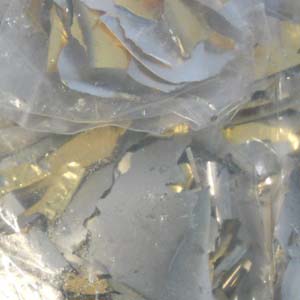Why Recycling Plating Tank Scrap Can Pay You More than You Expect
If you work directly in manufacturing processes that include electroplating, you already know how tank electroplating works. If you’re an executive at a company where electroplating is done, you might not know the details. Here’s a review of the basics, because what you don’t know could be costing your company money that the best precious metals recycling companies can add back into your bottom line.
Shown: Photo of electroplating tank scrap that customers have shipped to Specialty Metals for the recycling of precious metals at the best prices.
How Does Tank Electroplating Work?
Two metallic parts are immersed in a fluid called an electrolyte, which contains dissolved metal salts and other chemicals that allow charged atoms to pass through it. One of the immersed metal parts is the anode, which is made of the gold, silver, or other metal that you want to apply to the surface to be plated. The other immersed metal part, the cathode, is the part that you want to be plated.
Once everything is set up, an electrical current is run through the tank. That causes atoms in the anode to dissolve in the electrolyte solution and find their way to the cathode, where they adhere.
That’s the basic info. It’s a simple process that has been used to apply metal platings to everything from jewelry to belt buckles for years.
What Kinds of Metals Can Be Electroplated?
Commonly plated metals include gold, silver, platinum, rhodium, palladium, osmium, and iridium. Alloys can be applied via electroplating too. They include alloys containing gold, cadmium, cobalt, copper, and silver.
Why Do Plating Tanks Get Contaminated?
In an ideal world, the gold or other metal that you want to apply would jump right off your anode, swim straight to what you are plating (your cathode), and stick only there. But in the real world of plating processes, it doesn’t happen quite that neatly. The rare metal that you are applying doesn’t only adhere to the piece you are trying to plate. It’s kind of ornery, and tends to adhere to the side of the tank, to drain pipes, to filtering screens, to sensors that are immersed in the tank, and to the walls of the tank itself.
The result is that the tank, and those components, can become plated with residue that contains significant quantities of the precious metal you are using. That residue might not look like the bright shiny gold or silver or platinum that you are applying, but it might contain significant amounts of those rare metals anyway. The same can be true of the electrolytic fluid that you use in your plating; when you dispose of it, you could be disposing of valuable precious metal at the same time.
The result? When tanks, drain pipes, and other components become sufficiently contaminated after use, the quality of your platings can become compromised. Instead of only plating your parts with the precious metal you intend to, other elements that have contaminated your electrolytic fluid can stick to them too. At that point, you are faced with some choices. You could scrub and clean the tanks, which needlessly discards quantities of precious metals. Or you could call Specialty Metals Smelters and Refiners at 800-426-2344 to discuss the used tank scrap and other plating components that you have. We’re ready to recommend strategies that will help you recoup the value in the precious metals you have been using in your plating processes.
How Can You Find Hidden Dollars in Precious Metal Plated Scrap?
You could have traces of precious metals on your tank surfaces, on filter screens, in drain pipes, in accumulations of sludge, or on immersed sensors. And if you use a brush plating process in which an electrically charged metal brush is used to apply precious metal to the pieces you want to plate, your used plating brushes can contain precious metals too. Unless you call Specialty Metals Smelters and Refiners at 800-426-2344 to discuss your used tank scrap and other recyclables, you could be throwing dollars away.

